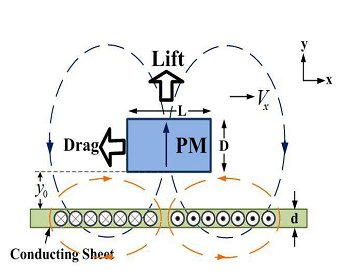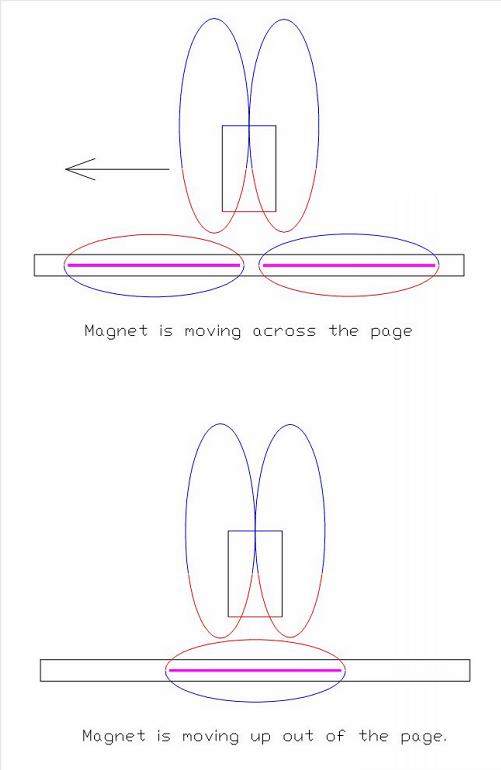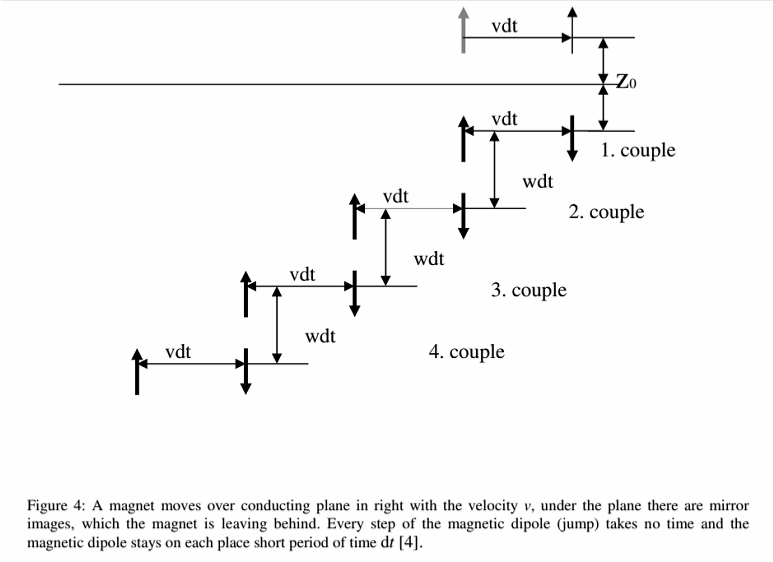
Electrodynamic Suspension And Braking
Electrodynamic suspension and braking appear to be the reciprocal of the same phenomenon. Electrodynamic braking of motors or generators by reversing the windings is not what is being discussed here.
Electrodynamic Braking has been used for many years. One application is slowing roller coaster cars. Large copper plates are fixed to the sides of the cars, and large magnets are fixed to the stopping area. Or vice versa. A clearance is left between magnets and plates. The speed of the car is rapidly diminished as it passes the magnets. Heat is generated in the copper plates, but there is no friction. Magnetic fields created in the copper plate is the same polarity as the magnet being passed. This creates a repelling effect, or lift. If lift is impossible the result is drag.
Electrodynamic Suspension is similar to Electrodynamic Braking, but makes use of the lift not the drag. An example is the magnetically levitating Inductrac Train. The train car has magnets fitted underneath, moving close to aluminum bars or shorted copper coils in the ground. The train achieves lift from the rails at a relatively slow speed of about 2MPH. The faster the train moves, the lift increases and the drag decreases. This is quite different to aircraft, where increased speed will give increased lift but also increased drag. Electrodynamic suspension is being discussed here as a means to create a friction free levitating rotor motor.
Does Electrodynamic Suspension Work In The Way We Believe?
The diagram below is a random example from explanations commonly used to describe how the electric currents and associated magnetic fields create opposing magnetic fields

The fields as shown above seem to be impossible. The fields must be opposing, but appear to be shown attracting. Opposing fields can be shown experimentally to oppose or exclude the other field. Using iron filings sparingly it shows a gap where iron is repelled, too much iron and the effect becomes attraction.
The fields as shown below are better, but it is obvious that the arrangement is impossible.
The fields as shown below are better, but it is obvious that the arrangement is impossible.

Above is my interpretation of the fields created. The pink bars represent Eddy Currents being created inside a non magnetic conductor.
If the eddy currents create an opposing or repelling field, it would then be impossible for the field from the moving magnet to continue penetrating into the conductor, therefore the lift (or braking) would cease. The eddy currents are said to create a field which always opposes the field which creates it. Sometimes the fields are referred to as a mirror image of the permanent magnet. As shown above, where the magnet is moving across the page, the eddy currents must make both polarities, that is, an opposing field above the conductor and the opposite polarity below the conductor.
If Hall Effect sensors are placed under the conductor, they should show a south pole (blue mirror image or virtual magnet), and then a north pole as the permanent magnet moves across the conductor.
My tests with actual magnets, conductors and sensors show that the permanent magnet's polarity and field strength where it penetrates under the conductor does not change, whether the magnet is moving or stationary.
There may be much more to this suspension or levitation than what is commonly believed.
If the eddy currents create an opposing or repelling field, it would then be impossible for the field from the moving magnet to continue penetrating into the conductor, therefore the lift (or braking) would cease. The eddy currents are said to create a field which always opposes the field which creates it. Sometimes the fields are referred to as a mirror image of the permanent magnet. As shown above, where the magnet is moving across the page, the eddy currents must make both polarities, that is, an opposing field above the conductor and the opposite polarity below the conductor.
If Hall Effect sensors are placed under the conductor, they should show a south pole (blue mirror image or virtual magnet), and then a north pole as the permanent magnet moves across the conductor.
My tests with actual magnets, conductors and sensors show that the permanent magnet's polarity and field strength where it penetrates under the conductor does not change, whether the magnet is moving or stationary.
There may be much more to this suspension or levitation than what is commonly believed.
I have found an interesting paper authored by Jure Hribar Dated 11 4 2008 and titled
Magnetic Braking
From
UNIVERSITY OF LJUBLJANA FACULTY OF MATHEMATICS AND PHYSICS
DEPARTMENT OF PHYSICS
Image method based on Maxwell's equations (The Principle of Mirror Images)
The author shows that there is a definite relationship between lift and drag. While drag increases linearly with increased velocity, lift is exponential. At some velocity the drag reduces, while lift increases. According to the author, this exponential gain is derived by summing the total force of all magnetic mirror images below the plane or conductor.
Magnetic Braking
From
UNIVERSITY OF LJUBLJANA FACULTY OF MATHEMATICS AND PHYSICS
DEPARTMENT OF PHYSICS
Image method based on Maxwell's equations (The Principle of Mirror Images)
The author shows that there is a definite relationship between lift and drag. While drag increases linearly with increased velocity, lift is exponential. At some velocity the drag reduces, while lift increases. According to the author, this exponential gain is derived by summing the total force of all magnetic mirror images below the plane or conductor.

Unfortunately there is no clear explanation of how this huge force below the plane is able to operate on the magnet above the plane.
My thoughts are that this electrodynamic suspension field is a the same as the Earth's magnetic field, which I refer to as a Dynamic Gravitational Field. The Earth's DGF is huge, and science has never been able to explain or duplicate this field.
I suspect that the paper above may unwittingly be describing Earth's DGF huge extent.
My thoughts are that this electrodynamic suspension field is a the same as the Earth's magnetic field, which I refer to as a Dynamic Gravitational Field. The Earth's DGF is huge, and science has never been able to explain or duplicate this field.
I suspect that the paper above may unwittingly be describing Earth's DGF huge extent.



